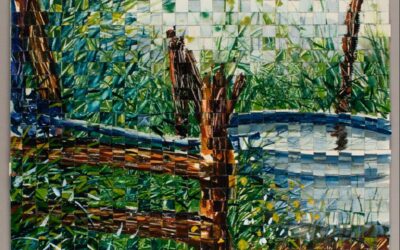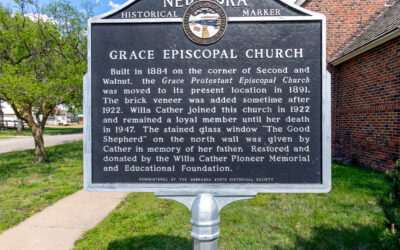
Marker Text
Here in 1846 an oppressed people fleeing from a vengeful mob found a haven in the wilderness. Winter Quarters, established under the direction of the Mormon leader Brigham Young, sheltered more than 3,000 people during the winter of 1846-1847. Housed in log cabins, sod houses and dugouts, they lacked adequate provisions. When spring arrived more than six hundred of the faithful lay buried in the cemetery on the hill. Winter Quarters became the administration center of a great religious movement.
In the spring of 1847 a pioneer band left Winter Quarters to cross the Plains to the Great Salt Lake Valley. Thousands of other followed this trail. In 1855, Young was forced to utilize handcarts for transportation. The first company, comprising about five hundred persons, left here on July 17 and reached the Valley on September 26, 1856.
The town of Florence, established in 1854, was built upon the site of Winter Quarters. James C. Mitchell and Associates of the Florence Land Company established a thriving community. The Bank of Florence, built in 1856, stands today as a symbol of our historical past.
Further Information
During their trek from Illinois to Utah, the Mormons took up residence in what they called Winter Quarters, a settlement in modern-day Omaha. They stayed there from 1846 to 1848. Mormons: Joseph Smith of New York first began experiencing visions in 1820. These visions and the purported finding of some ancient gold plates buried underground led to the creation of the Mormon religion. Smith and his followers believed that Mormonism was the restoration of true Christianity, which had been perverted by mainstream Christian denominations.
The Book of Mormon was first published in 1830. That same year, Mormon missionaries began to move west, establishing settlements in Kirtland, Ohio and Independence, Missouri. Mormons in these places began to experience discrimination. In 1838, they were expelled from Missouri but found refuge in Nauvoo, Illinois. In 1844, Smith announced he was running for president but was arrested after calling for the destruction of an anti-Mormon newspaper in the town. While he was in jail, a mob shot and killed him and his brother, Hyrum.
The Exodus
In February of 1846, most Mormons in Nauvoo decided to disperse and find a more peaceful home. Some went to Michigan and others went to various other places in the East and Midwest. The majority, however, followed Brigham Young west, where they sought out a place to build their home somewhere in the Rocky Mountains. As the Mormons traveled west, they kept away from the established western trails so avoid entanglements with non-Mormon travelers.
The Founding of Winter Quarters
Young and the other Mormons knew they could not make it all the way to the Rockies in one season, especially in the winter. They decided to create a temporary settlement somewhere between Nauvoo and the Rockies. In the summer of 1846, the Mormons reached the Missouri and planned to cross it. Originally, they sought to go as far as Grand Island, where they would establish winter quarters. Problems quickly arose. At the time, land west of the Missouri was set aside as Indian Country. Whites were only allowed to enter the territory with the proper passports. The Mormons created problems firstly because they were a large group of people all seeking to cross at once and secondly because they were a “peculiar” religious minority that many people distrusted. In April of 1846, the Mexican-American War began. President Polk requested 500 volunteers from the Mormon people to fight in the war. Brigham Young made an informal agreement whereby the Mormons would agree to fight if they were allowed to camp out in Indian Country. Young also made informal agreement with the Omaha and Potawatomi Tribes ensuring the validity of their settlements. The tribes agreed because they saw the Mormons as a buffer between them and the belligerent Sioux. That August, despite any official permission to do so, Young and his people established “Winter Quarters of the High Council of the Camp of Israel” on the western bank of the Missouri. About 10,000 Mormons lived in Winter Quarters while 3,000 stayed in Iowa.
Life in Winter Quarters
Winter Quarters, while only a temporary home, was very well-designed and built. It was a planned city with streets in a grid system creating 41 blocks and including 820 lots. Most houses were log cabins, but some families resided in earthen dugouts. The city was built quickly; by 1847, there were 1,000 houses in the town. Houses for widows and the poor were given priority. A stockade was built surrounding the city, and a blockhouse with some crude fortifications was added to protect against hostile Native Americans. In addition to houses, the Mormons built schools, churches and a mill. Winter Quarters was governed by a high council, which was both a religious and civil body. It organized a mail service and police force. Residents of Winter Quarters got supplies the first year mainly through trading either at the Sarpy trading post near modern-day Bellevue or with residents of Iowa. After the first year, they sustained themselves with crops. Hunting and gathering also provided them with food. Residents of Winter Quarters experienced many illnesses. Scurvy, typhoid, malaria and diphtheria (collectively called “the fever”) were common. Scurvy was caused by the lack of diversity in the diet. The “fever” was the deadliest affliction. The swampy conditions near the Missouri River made it a common and dangerous illness. About 600 people died in the two years the Mormons spent in Winter Quarters, most of them presumably killed by illness. By 1847, though, the community was generally healthy. Despite the harsh conditions of the frontier, life in Winter Quarters was vibrant. Dances and music were common. Religious activities were the center of life. Intellectual pursuits and education were also important features of the community.
Future Plans
Brigham Young and other Mormon leaders wanted to move the Mormons to the Rockies. The community at Winter Quarters was divided into various groups to organize the movement west. Young and some other leaders planned to go ahead to scout out a place to make their home. They left on April 7, 1847 with a party of 148. Upon reaching the Salt Lake Valley, Young knew he had found the place. His party returned to Winter Quarters on October 31. The rest of the Mormons could not leave immediately since it was almost winter.
Problems
Young insisted that the town would only be temporary, but government agents saw how well-built everything was and inferred that it would be a more permanent home. Winter Quarters was already illegal, and the government feared dire consequences if the Mormons made a permanent home in Indian land. Furthermore, disputes between the Omaha people and the Mormons began to grow. The Omaha stole many Mormon cattle, feeling justified since the Mormons were trespassing on their land. The Mormons successfully avoided any violent encounters with the Omaha; their philosophy was that it was cheaper to feed the Indians than to fight them. Still, relations were not good between the two. The government wanted the Mormons to leave but feared bloodshed and scandal if they were forced to leave.
The End of Winter Quarters
These problems were mostly resolved in 1848. Young had established Salt Lake City as the permanent home of Mormons in the west. He figured that the Mormons would still need a halfway station on the way to Utah, but that, in order to avoid further conflicts, it should be moved to Iowa. In January of 1848, Winter Quarters was closed, and all its inhabitants were told to either move to Utah or Iowa. The new halfway station created by the Mormons was called Kanesville, which was later renamed Council Bluffs. The city of Florence was created in 1854 on the site of Winter Quarters. Mormon emigrants continued to use Florence as a stopping point on the way to Utah until 1863. Florence began to decline in population and prestige after that and was later annexed by the city of Omaha. The Mormon cemetery still resides at the site.
Mormons in Nebraska
Not all the Mormons in Winter Quarters, Florence and Council Bluffs left for Utah. A small but significant number remained in the region and played a key role in the formation of Nebraska. Orson Hyde, a Mormon leader, became politically involved in Council Bluffs. He started a newspaper, the Frontier Guardian, which advocated Whig politics and Mormon values. Orson Hyde left Council Bluffs in 1852. In 1853 his paper was combined with another local paper, the Council Bluffs Beagle, in 1853 by Joseph Ellis Johnson, another Mormon. Johnson became interested in Omaha politics and used the Bugle offices to print the Omaha Arrow. The Arrow became a leading voice supporting the development of Omaha. When Omaha became the capitol, a Bellevue newspaper blamed Johnson and wrote a fictional letter from Joseph Smith to Johnson mocking both Mormons and Omaha. Brigham Young had planned to build a series of settlements along the Mormon Trail. This was opposed by many Nebraskans who feared that the Mormons would try to take over the politics of the state. The plan fell through when disputes between the government and Mormons in Utah arose. Many Mormons continued to travel through the state on the way to Utah, but fewer and fewer stayed in Nebraska. By the time the Transcontinental Railroad was completed in 1869, Mormon influence in Nebraska was almost gone. There are still some Mormons in the state today, but they are a small minority.
Bibliography / Read on
- Danker, Donald F. “The Nebraska Winter Quarters Company and Florence.” Nebraska History. March 1956: 27-50.
- Homer, Michael W. “After Winter Quarters and Council Bluffs: The Mormons in Nebraska Territory, 1854-1867.” Nebraska History. Winter 1984: 467-483.
- Shumway, E. Widstoe. “Winter Quarters, Nebraska, 1846-1848.” Nebraska History. June 1954: 115-125..
- Shumway, E. Widstoe. “Winter Quarters, Nebraska, 1846-1848: Aspects of Camp Life.” Nebraska History. March 1955: 43-53.
- “Timeline: The Early History of the Mormons.” The Mormons. PBS.org.
- Trennert, Jr., Robert A. “The Mormons and the Office of Indian Affairs: The Conflict Over Winter Quarters, 1846-1848.” Nebraska History. Fall 1972: 381-400.




